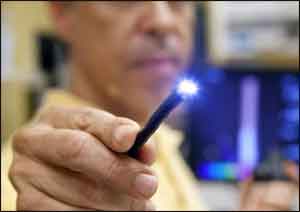- Home
- Editorial
- News
- Practice Guidelines
- Anesthesiology Guidelines
- Cancer Guidelines
- Cardiac Sciences Guidelines
- Critical Care Guidelines
- Dentistry Guidelines
- Dermatology Guidelines
- Diabetes and Endo Guidelines
- Diagnostics Guidelines
- ENT Guidelines
- Featured Practice Guidelines
- Gastroenterology Guidelines
- Geriatrics Guidelines
- Medicine Guidelines
- Nephrology Guidelines
- Neurosciences Guidelines
- Obs and Gynae Guidelines
- Ophthalmology Guidelines
- Orthopaedics Guidelines
- Paediatrics Guidelines
- Psychiatry Guidelines
- Pulmonology Guidelines
- Radiology Guidelines
- Surgery Guidelines
- Urology Guidelines
Indian origin scientist develops a camera that can see through the human body

An Indian origin scientist Kev Dhaliwal, Profesor of molecular imaging and healthcare technology at university of Edinburgh has led a team of his university in collaboration with Heriot-Watt University for developing a new camera which can see through the human body. The project is part of the Proteus Interdisciplinary Research Collaboration, which is developing a range of new technologies for diagnosing and treating lung diseases.The device is designed to help doctors track endoscopes, used to investigate a range of internal conditions without using X-rays or other expensive methods.
The new camera works by detecting light sources inside the body, such as the illuminated tip of the endoscope's long flexible tube.
Professor Kev Dhaliwal of the University of Edinburgh, said: “This has immense potential for diverse applications.“The ability to see a device’s location is crucial for many applications in healthcare, as we move forwards with minimally invasive approaches to treating disease.”
 Image source: BBC News
Image source: BBC NewsEarly tests have shown the prototype device can track a point light source through 20cm of tissue under normal conditions. As of now beams from the endoscope can pass through the body, but usually scatter or bounce off tissues and organs rather than travelling straight through thereby implying that it is problematic to get a clear picture of where the tool is located.
 Image Source: Deccan Herald
Image Source: Deccan HeraldThe new camera can be used at the patient’s bedside and it can detect individual particles, called photons. Moreover ,it is extremely sensitive and therefore can catch tiny traces of light passing through tissues. The device can also record the time taken for light to pass through the body, meaning that it is able to work out exactly where the endoscope is.
Dr Michael Tanner, of Heriot-Watt University, said: “My favourite element of this work was the ability to work with clinicians to understand a practical healthcare challenge, then tailor advanced technologies and principles that would not normally make it out of a physics lab to solve real problems.
"I hope we can continue this interdisciplinary approach to make a real difference in healthcare technology." It is hoped that this new camera in addition to ability to see through human body shall cut costs for hospitals.

Disclaimer: This site is primarily intended for healthcare professionals. Any content/information on this website does not replace the advice of medical and/or health professionals and should not be construed as medical/diagnostic advice/endorsement or prescription. Use of this site is subject to our terms of use, privacy policy, advertisement policy. © 2020 Minerva Medical Treatment Pvt Ltd